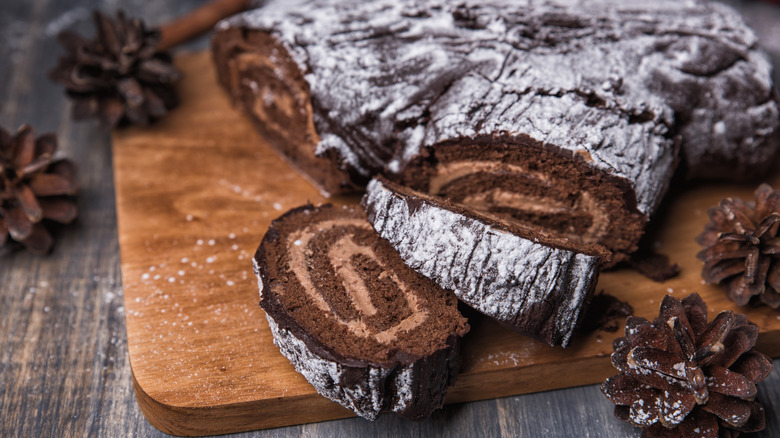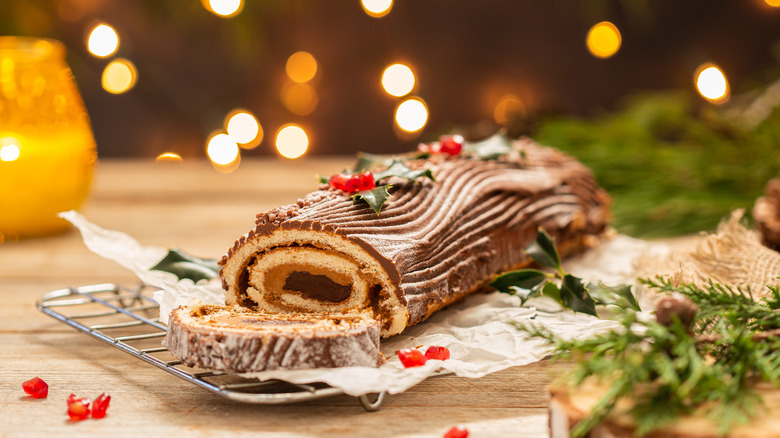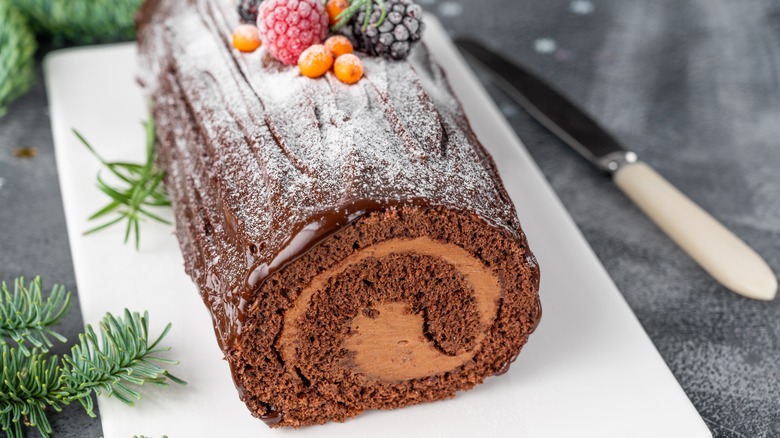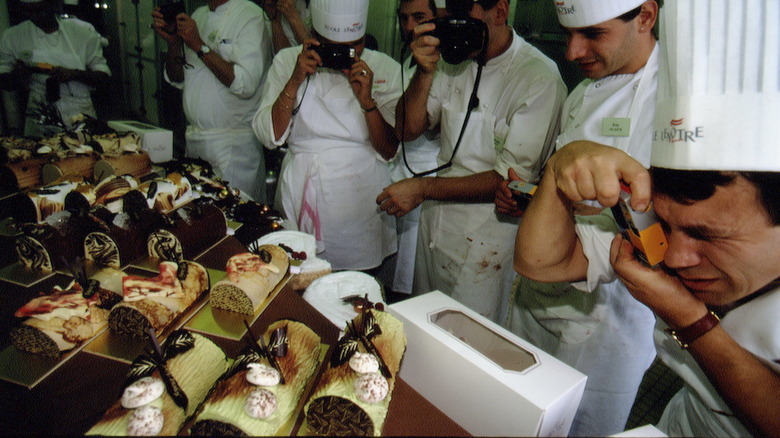How Yule Log Cakes Became A Christmas Tradition
Many things can symbolize Christmas depending on the family traditions you grew up with, but one thing that's almost universally a sign that the holidays are here is a yule log or "bûche de Noël" as some call it. We're not talking about the cozy faux-fireplace image that flickers on your TV screen for hours and hours. Alas, we're referring to the tasty sponge cake with some variation of a delicious filling, rolled to perfection and decorated like a snow-covered log in a wintery forest.
So where did this tasty and decorative dessert come from? And how did it become attached to the Christmas holiday? It actually has an interesting and slightly twisted history that starts with Thor and ends with your family Christmas party. The roots of Christmas as a celebration are found in the Scandinavian celebration of Yule, which celebrates the winter equinox and the coming of longer, warmer days. Though we don't know exactly when the first yule log cake was created, it was well after Christmas started transitioning into the celebration we know today. The first recipe was written by French pastry chef Pierre Lacam and published in the 1895 cookbook "Le Mémorial Historique et Géographique de la Pâtisserie."
History of the yule log
The name yule log came from pre-Industrial Europe where local Victorians were burning actual logs in honor of the Norse god, Thor as part of a Norse winter festival, per Atlas Obscura. Old Viking traditions spread throughout Europe as the Vikings ransacked towns, and while their reign may have ended, their traditions stuck and intertwined with existing European solstice events, including one tradition that burned logs to keep out winter darkness. The larger the log, the longer it could burn and ideally, it would last through the night. That same remnant, aka the yule log, would then be saved and burned the following year to symbolize a sense of continuity. The log was said to have protective powers if you slept with it under your bed, so you're starting to get a sense of reverence for this large piece of wood.
When it comes to burning the log, the French had their own way of doing things that involved embellishing the sacred log with things like a bed of moss, a sprinkle of olive oil or honey, or even some wine (how very French), per My Parisian Kitchen. Maybe that's where the modern decoration came from, with meringue mushrooms or crushed pistachios for moss? Eventually, as things modernized, the tradition changed to accommodate smaller fireplaces and eventually transformed into delicious chocolate or vanilla yule log that was purely symbolic. Leave it to the French to make a mouth-watering pastry out of things!
Where did the cake originate?
Michael Krondl, the author of "Sweet Invention: A History of Dessert," posits that the bûche de Noël stemmed from a rise in the Parisian middle class' rail tourism. Krodl believes that the cake represented a rural Yule tradition for city folks who had fallen in love with their vacations in the countryside. The first mention of the cake may actually have been before the publication of Pierre Lacam's cookbook, Krondl writes in a blog post. In 1894, Alfred Suzanne casually noted in "La Cuisine Anglaise et la Pâtisserie" that the cake was a specialty of someone named Ozanne. Krondl also cites a roll cake decorated in chocolate ganache from an 1884 recipe collection belonging to chocolatier Stéphane Bonnat's great-grandfather. Though there's no indication that this cake was decorated as a yule log, it is a likely precursor.
The Yule log cake is, at its core, a rolled and filled sponge cake — historically called a Swiss roll, jelly cake, or jelly roll, which seems to have been invented in the 19th century, with references to its many names printed as early as 1852 — decorated to emulate a log. It's not hard to make the leap between a log of rolled cake to a cake that looks like a log as a Christmas treat.
The spread of tradition
Though the bûche de Noël has been claimed as a French creation, the cake certainly didn't take long to take root in other cultures and their holiday celebrations. In Italy, the cake is the "tronchetto di Natale:" Christmas log. It spread to other parts of Europe and it quickly became popular in nearby and Francophone countries like Belgium, Switzerland, French-Canadian territories, and Vietnam. In 1941, a Vietnamese newspaper advertised lessons for baking various French things, including the bûche de Noël. Vietnam was under French colonization at the time, of course, so it makes sense that the French dessert became popular in the Southeast Asian country. The tradition lives on today; according to Kinh Đô Bakery, they made 140,000 yule log cakes in 2010.
The cake is also a persisting tradition in the Appalachian Mountains of the U.S., where a number of Scottish and Irish emigrants settled. Susannah Gebhart, the owner of Old World Levain, a James Beard Awards semifinalist bakery in Asheville, North Carolina, ties in all of the values of her Appalachian bakery to the tradition by using all locally made ingredients to celebrate the area's heavily forested landscape. The bakery uses foraged hickory nuts, chestnut and acorn flour, foraged black walnuts, foraged evergreen hemlock, and local apples for their yule cakes. It may be a departure from the original recipe, but it holds the spirit of Yule — perhaps even more than the first log cake did in the 1800s.



